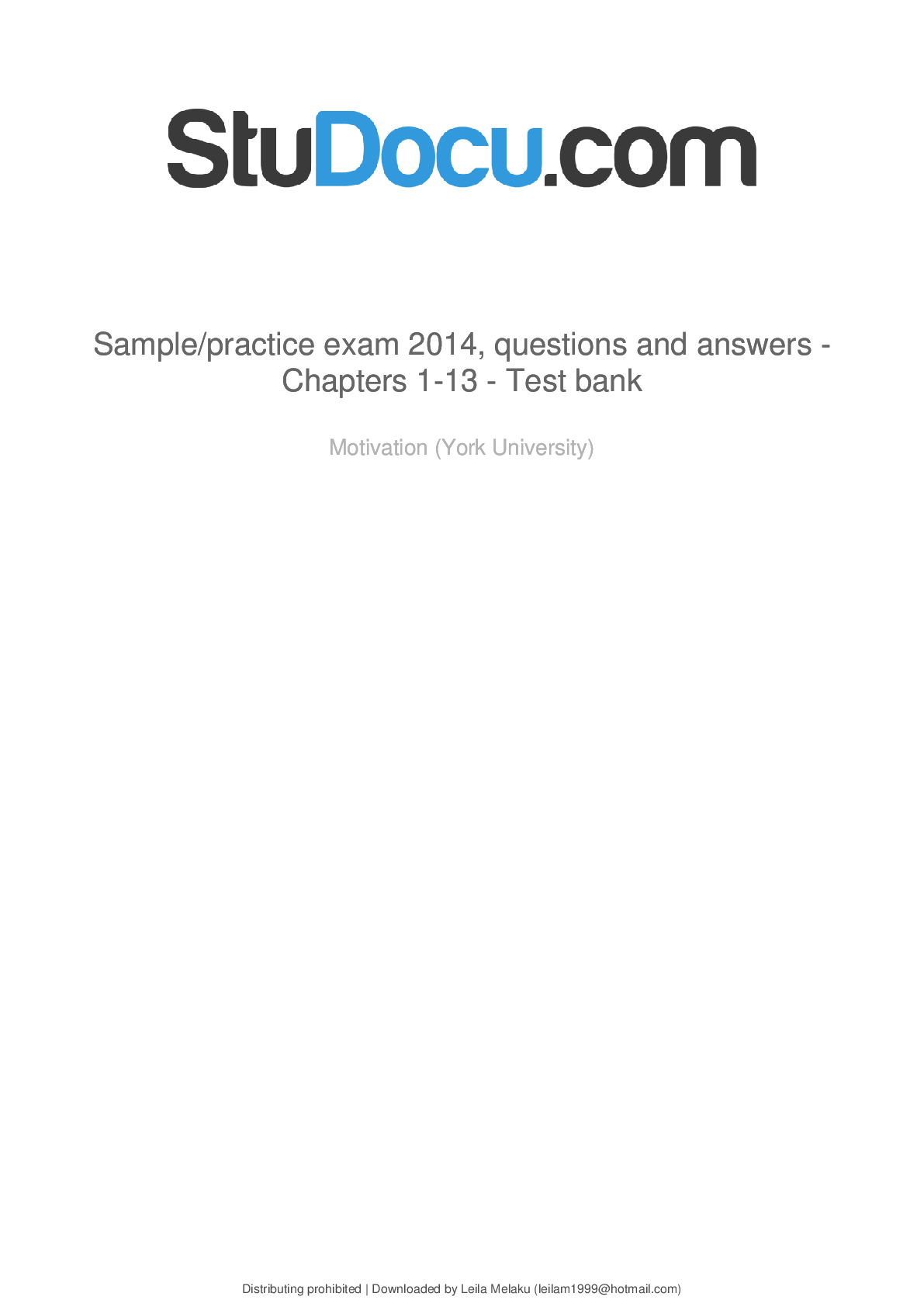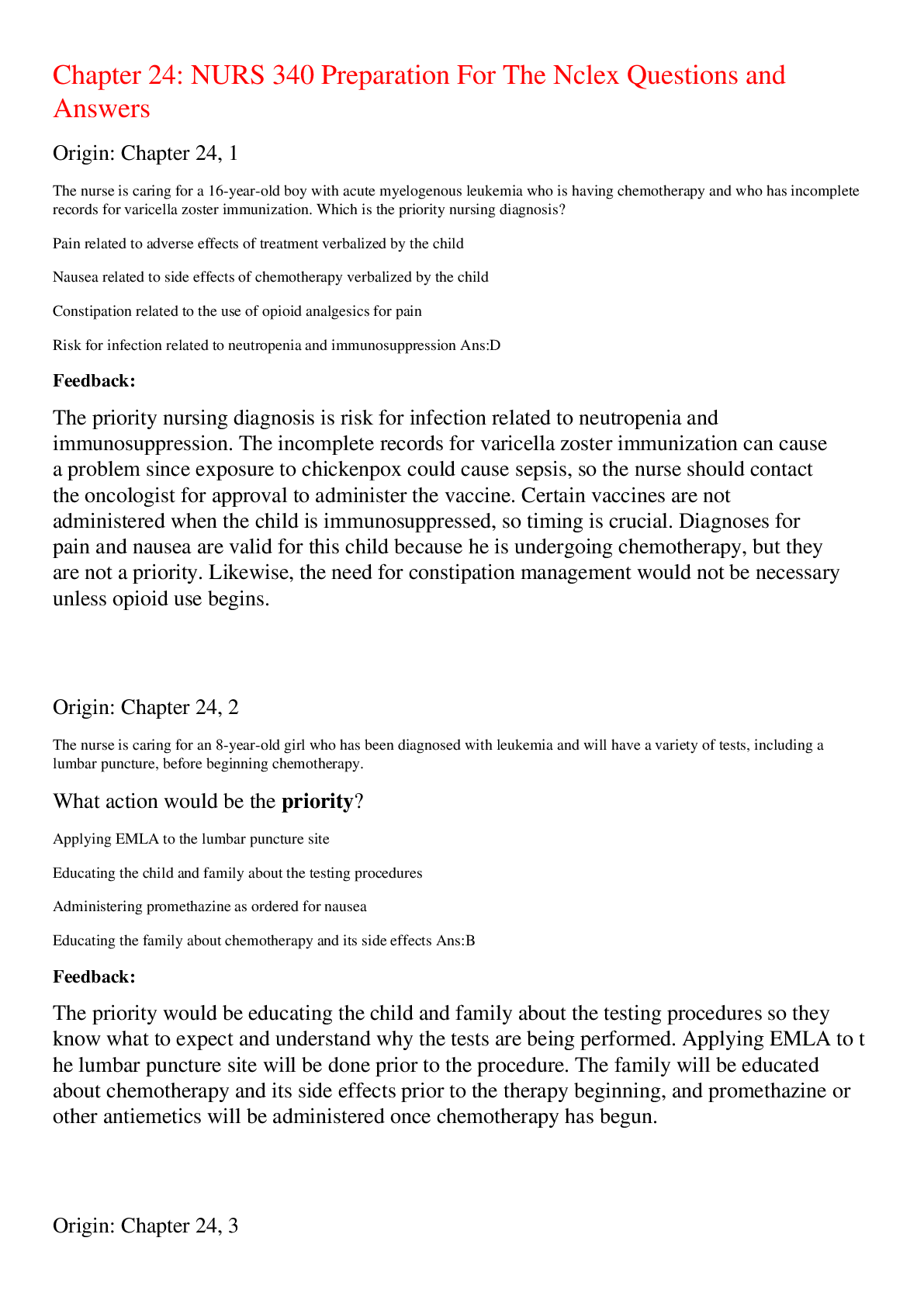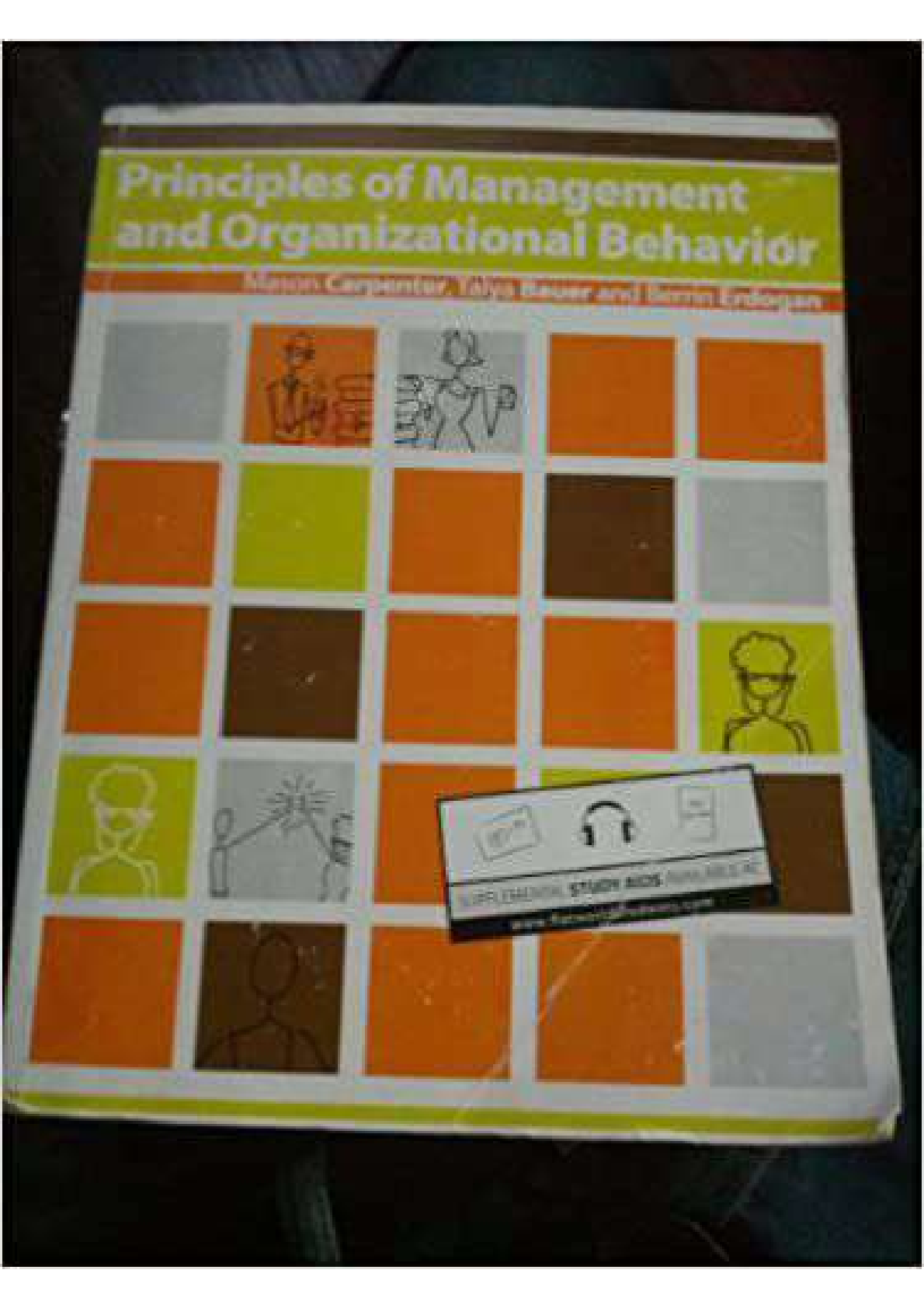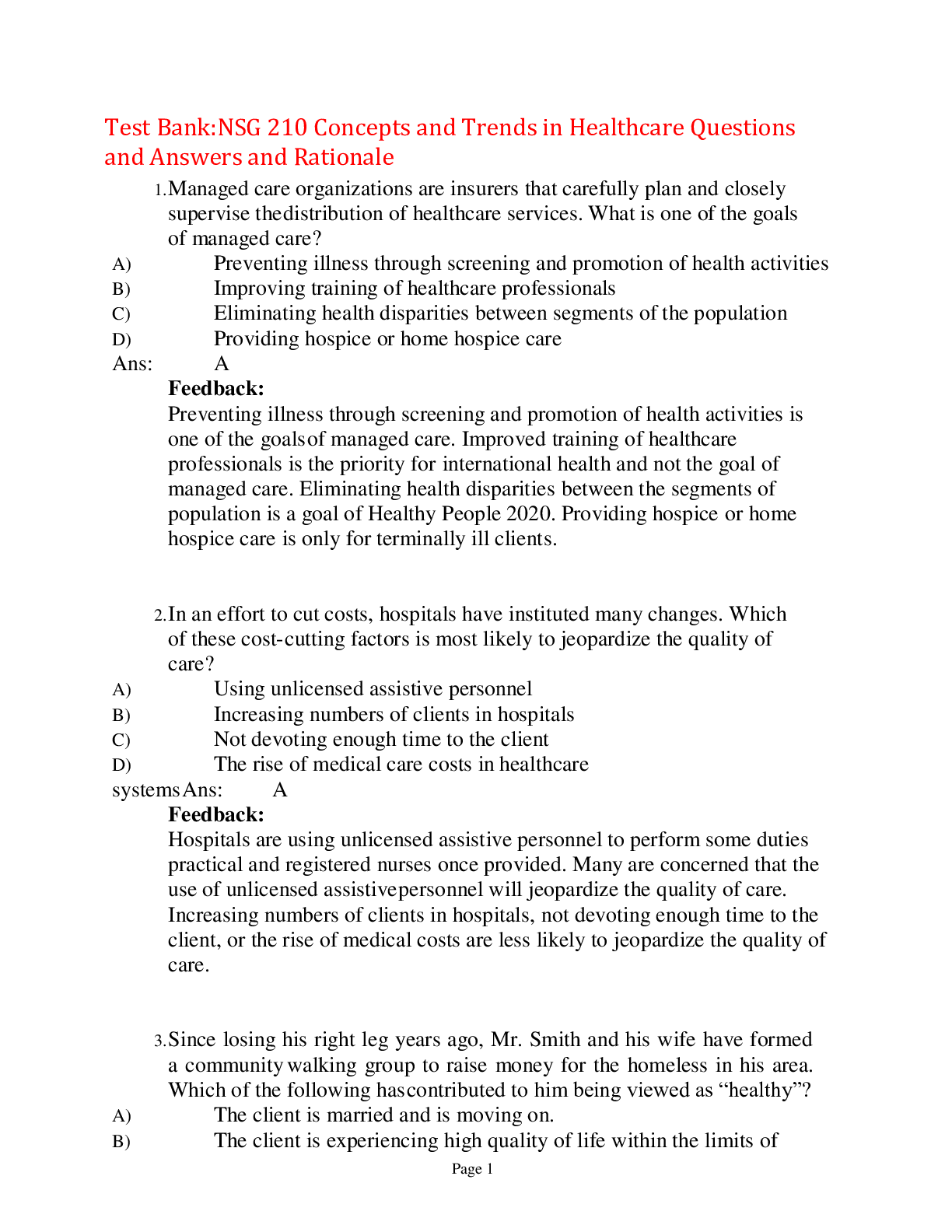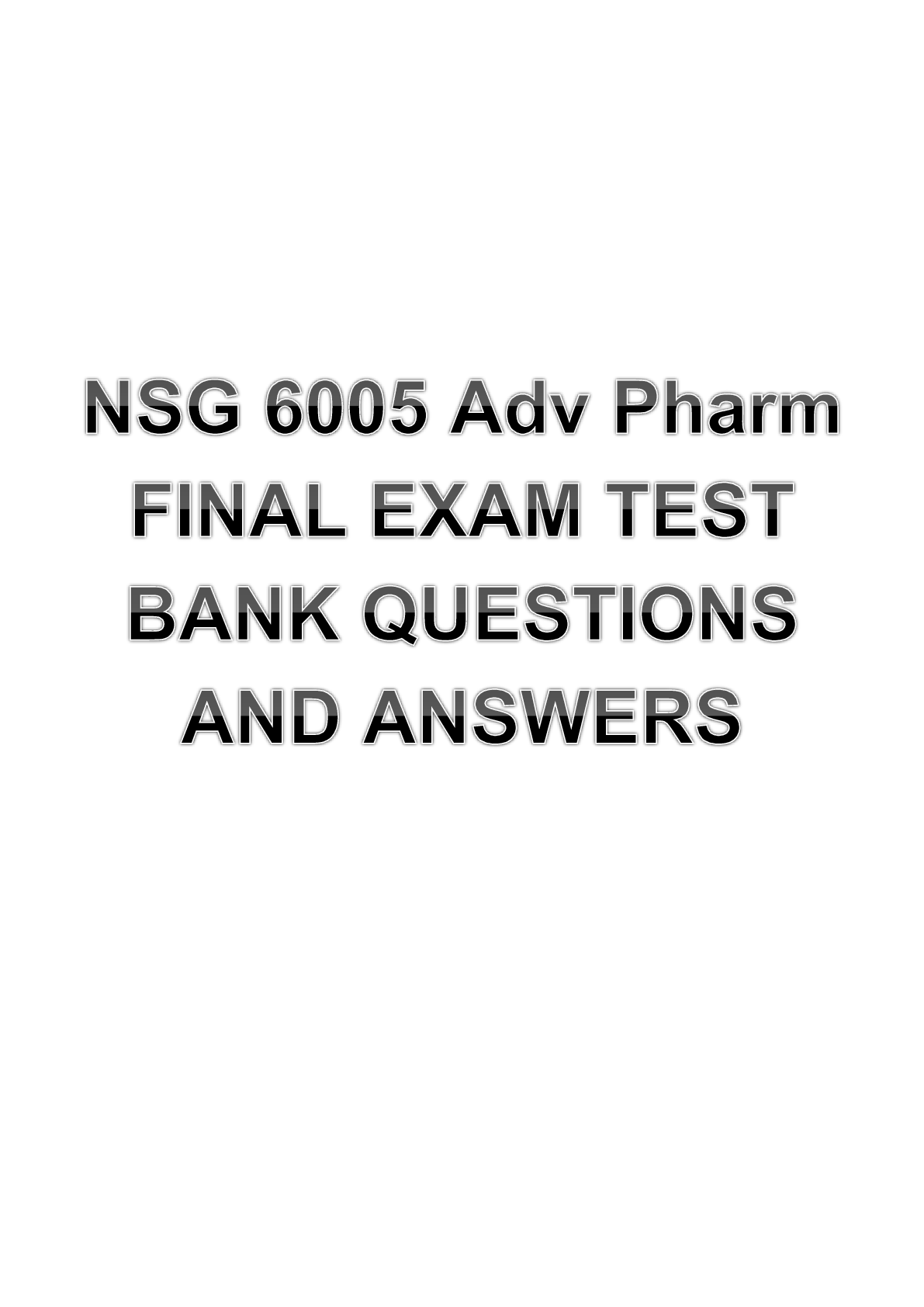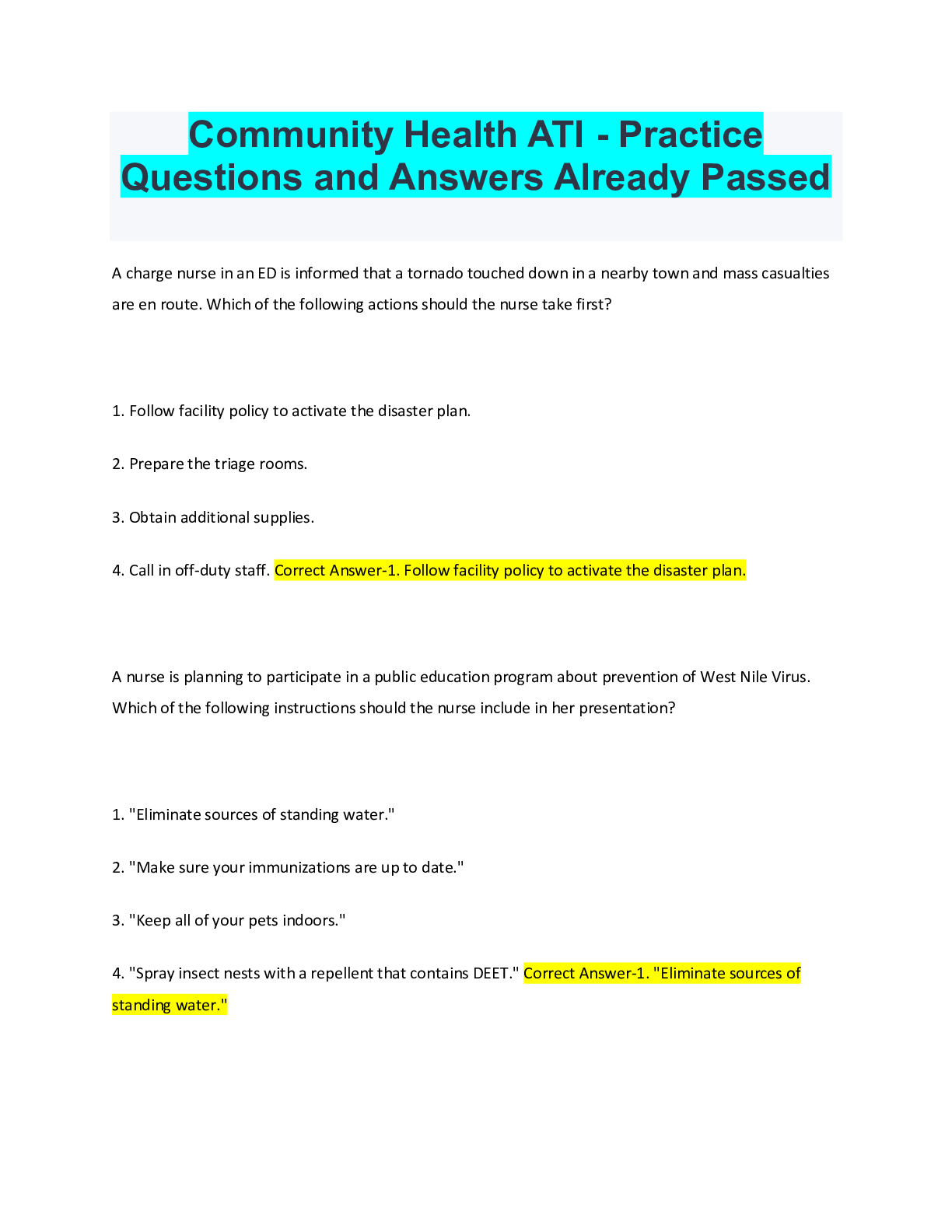*NURSING > TEST BANK > ATLS practice questions and answers Latest 2022(Real test bank graded A+) (All)
ATLS practice questions and answers Latest 2022(Real test bank graded A+)
Document Content and Description Below
ATLS practice questions and answers Latest 2022(Real test bank graded A+) Assessed first in trauma patient Correct answer- Airway (*)Degree of burn that is characterized by bone involvement Correc... t answer- Fourth Complications of head trauma Correct answer- Intracerebral hematoma Extradural hematoma Brain abscess Most common cause of laryngotracheal stenosis Correct answer- Trauma Intervention that can help prevent development of acute renal failure Correct answer- Infusion of normal saline A 26-year-old male is resuscitated with blood transfusion after a motor vehicle collision that was complicated by a fractured pelvis. A few hours later, the patient becomes febrile, hypotensive with a normal CVP, and oliguric. Upon examination, the patient is found to be bleeding from the NG tube and IV sites. Which of the following is the most likely diagnosis? A. Hemorrhagic shock B. Acute adrenal insufficiency C. Fat embolism syndrome D. Transfusion reaction Correct answer- D. Transfusion reaction Skin antiseptic Correct answer- -Ethanol 70% is an effective skin antiseptic -Acetic acid can be used to treat Gram- skin infections -Salicylic acid is used to treat certain skin yeast infections Class IV hemorrhage indicates what % blood loss Correct answer- 55% How does shivering affect body temperature Correct answer- Increases body temperature Class III hemorrhage indicates what % of blood loss Correct answer- 35% Management of a stable patient with kidney contusion Correct answer- Observation Associated with hypovolemic shock Correct answer- -Inadequate tissue perfusion with resultant tissue hypoxia -Blood shunting to vital organs -Decreased circulating blood volume and decreased venous return -Low cardiac output -Loss of less than 20% of the blood volume is usually without symptom except for mild tachycardia -Patients become orthostatic with losses between 20 and 40% -Shock is evidenced by tachycardia, hypotension, oliguria, flat neck veins The most effective method of monitoring the success of resuscitation during CPR? Correct answer- Reactivity of pupils to light Used to ensure correct placement of endotracheal tube Correct answer- -Ultrasound -Bilateral breath sounds -Sustained end-tidal CO2 Total body surface area involved in a burn in an adult to the anterior chest and abdomen Correct answer- 18% What is often caused by carotid massage? Correct answer- Bradycardia Step in a patient diagnosed with tension pneumothorax Correct answer- 1. Needle decompression/ thoracotomy 2. Chest tube True statements regarding diaphragmatic injuries Correct answer- -Blunt diaphragmatic injuries are usually associated with skeletal trauma -Penetrating diaphragmatic injuries may be missed -Repair of traumatic diaphragmatic injuries usually does not require prosthetic material First priority in the treatment of an unconscious patient Correct answer- Checking the pulse A patient involved in a road accident is brought to the emergency department in an unconscious state. On arrival, her vitals show a temperature of 96.4 degrees Fahrenheit, a respiration rate of 24 breaths per minute, a heart rate of 140 beats per minute, and a blood pressure of 80/40 mm Hg. She is cold, shivering, and perspiring profusely. She has bilateral reactive pupils but she does not respond to pain. On physical examination, she has no obvious sign of external bleeding. Which of the following cannot be the cause of hypotension in this patient? A. Pelvic fracture B. Fracture of femur C. Intracranial hemorrhage D. Hemothorax Correct answer- C. Intracranial hemorrhage A patient suffered a slash to his right neck. The wound is over the mid-portion of the sternocleidomastoid. There is a large hematoma and brisk bleeding when uncovered. He is stable. What is the next step in management? A. Get an angiogram B. Close the wound in the ER C. Take him to the operating room D. CT scan to evaluate neck structure Correct answer- C. Take him to the OR After abdominal injury, which of the following urinalysis findings would be an indication for further testing? A. 0-5 casts/HPF B. 5-10 WBC/HPF C. 10-20 RBC/HPF D. Gross hematuria Correct answer- D. Gross hematuria A laceration of the neck superficial to the deep cervical fascia along the sternocleidomastoid muscle at its midpoint would cause bleeding from which structure? Correct answer- External jugular vein Clinical features associated with tension pneumothorax Correct answer- Unilateral decrease in breath sounds Hyperresonance Respiratory distress Tachycardia Tracheal shift Desatruation Decreased breath sounds Decreased compliance Asymmetric chest movement NOT hypertension, audible bronchial sounds Not recommended as a mode of ventilation for a patient with a diaphragmatic hernia A. Bag and mask B. LMA C. Endotracheal intubation D. Jet ventilation Correct answer- A. Bag and mask What is the next step in the assessment of a traumatic patient after airway is established? Correct answer- Breathing Blood group that is considered a universal donor Correct answer- O A provider is examining a patient who sustained a severe traumatic head injury. He documents no Doll's eyes. What does this signify? Correct answer- Brainstem injury Which of the following is the least preferred method of administering IV fluids? A. Cubital veins B. Cephalic veins C. Subclavian veins D. Saphenous vein Correct answer- Subclavian veins Dermatome level for nipple sensation Dermatome level for umbilicus Correct answer- T4 T10 At which temperature would a hypothermic patient stop shivering? Correct answer- 88 degrees F What is the energy recommendation for the first defibrillation in an adult (*) Correct answer- 300 J Pharmacologic effects of Morphine Correct answer- Behavioral changes Analgesia Respiratory depression NOT diarrhea A patient with which condition should be triaged to receive medical attention first? A. Choking B. Dizziness C. Leg cramp D. Vomiting Correct answer- A. Choking For pediatric patients, what volume of fluid resuscitation should be given initially in the setting of shock? A. 750 mL of saline uniformly B. 1 liter of saline C. 20 mL/kg of 0.45% NaCl with 5% glucose D. 10 to 20 mL/kg of Ringers lactate Correct answer- D. 10 to 20 mL/kg of Ringers lactate A patient is found unconscious after a fire in his bedroom. He is found to have severe burns around his face. What is the first aspect of treatment? A. Tetanus toxoid B. Cover the wound C. Airway D. Obtain blood work Correct answer- C. Airway Basilar skull fracture Correct answer- PE: raccoon eyes, battle sign, CSF ottorrhea (rhinorrhea), loculated pneumoencephalocele Bone MC involved = Temporal A patient with von Willebrand disease is bleeding after sustaining a knife wound. Which of the following is most appropriate for the treatment of this patient? A. Vitamin K B. Cryoprecipitate C. Protamine D. DDAVP Correct answer- D. DDAVP Download to view full test bank [Show More]
Last updated: 11 months ago
Preview 1 out of 30 pages
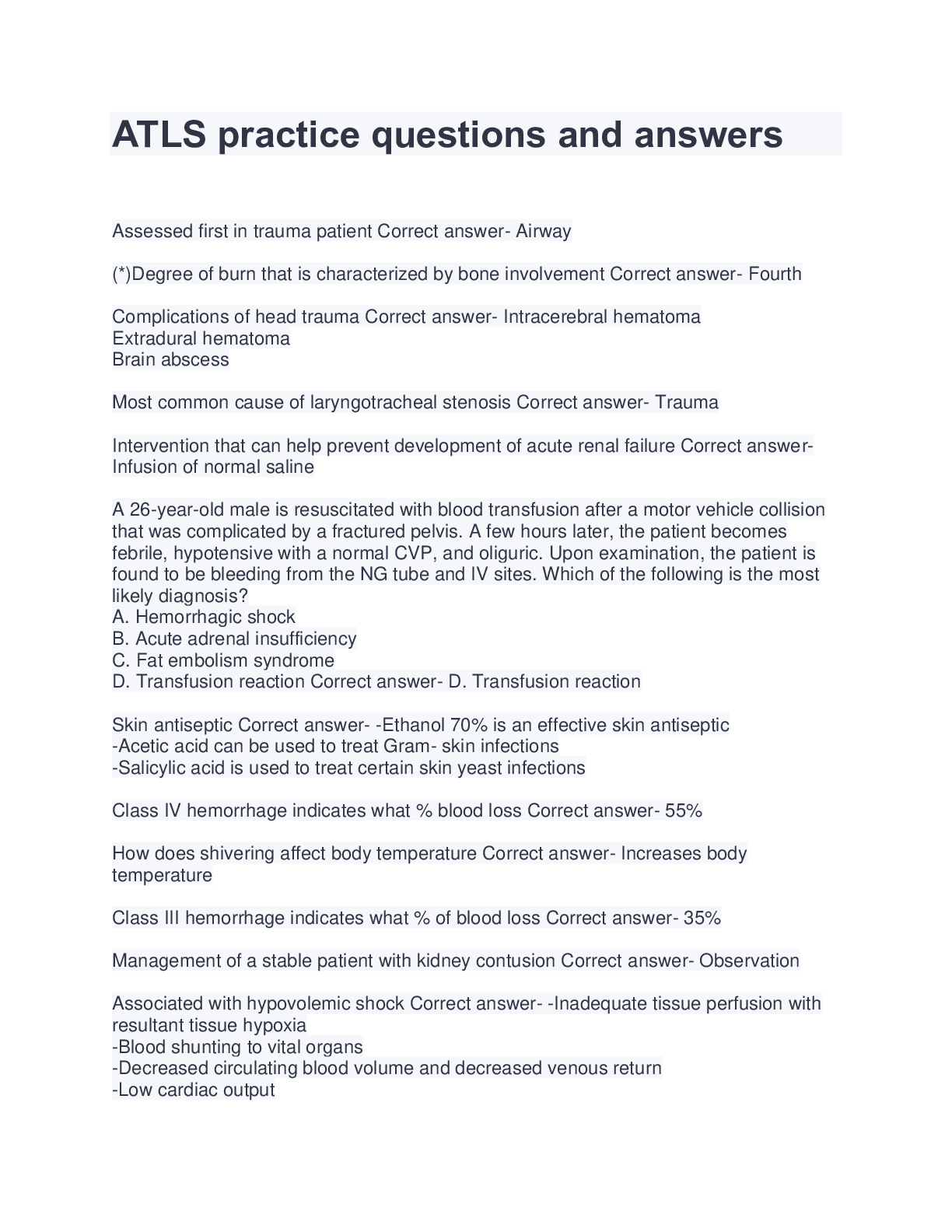
Reviews( 0 )
Document information
Connected school, study & course
About the document
Uploaded On
Jan 24, 2022
Number of pages
30
Written in
Additional information
This document has been written for:
Uploaded
Jan 24, 2022
Downloads
0
Views
58

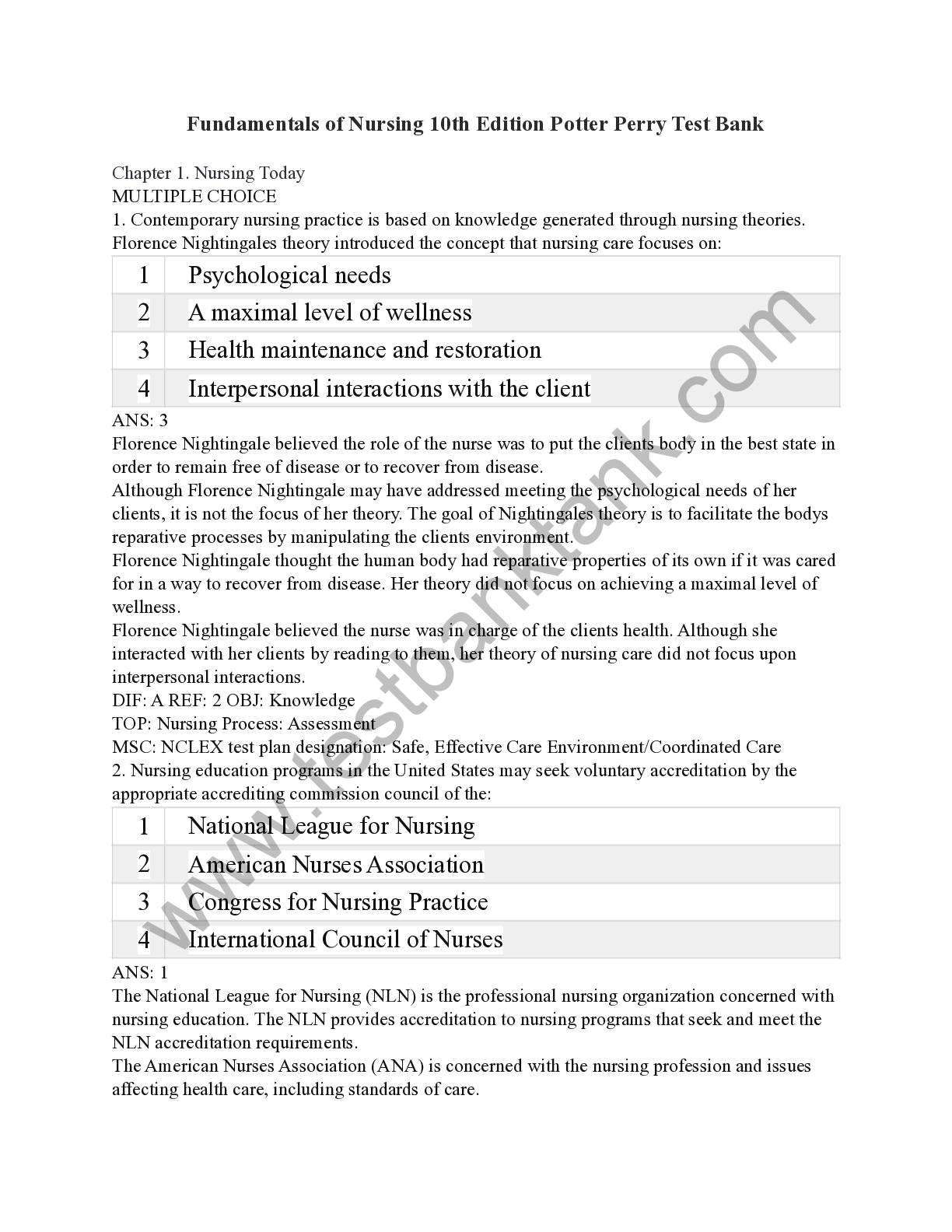

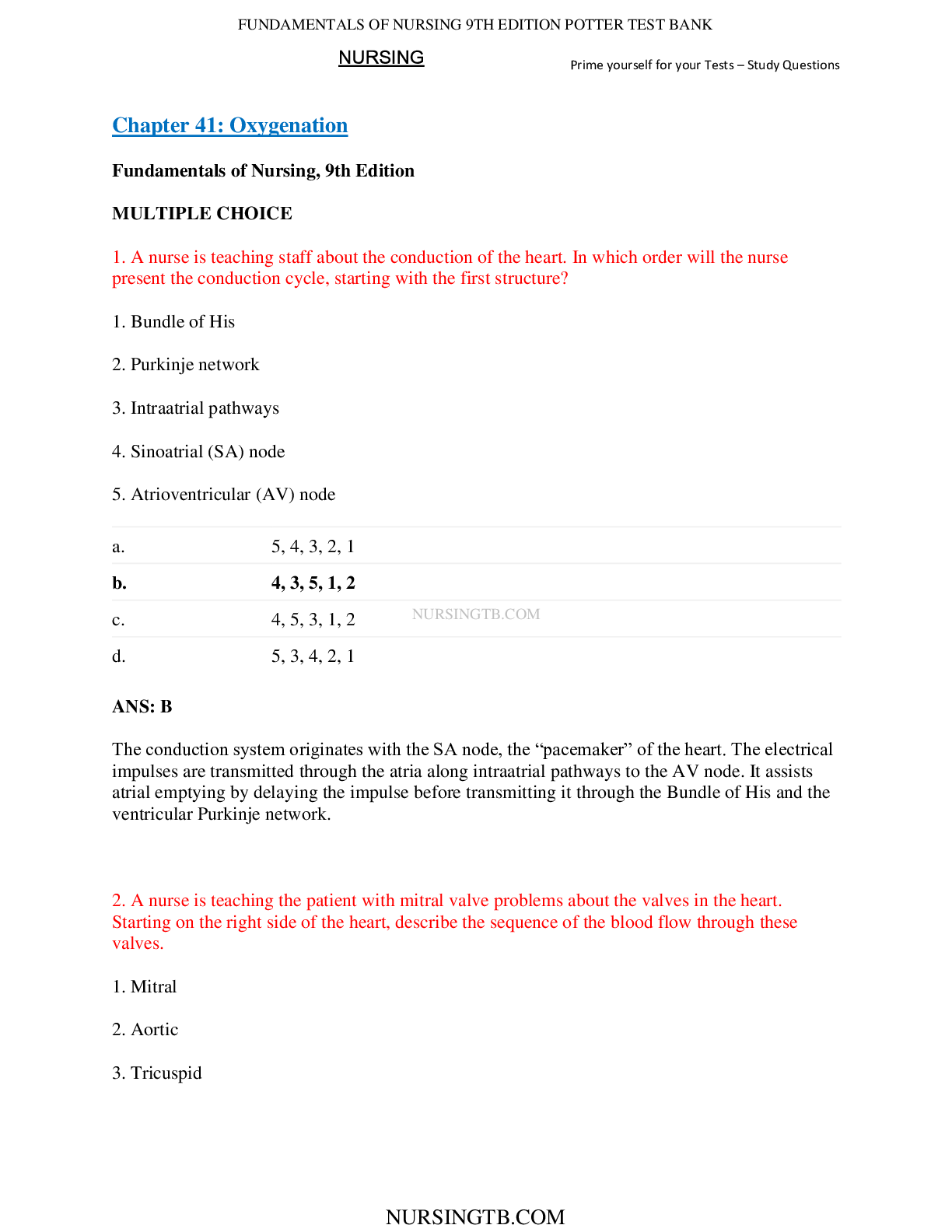

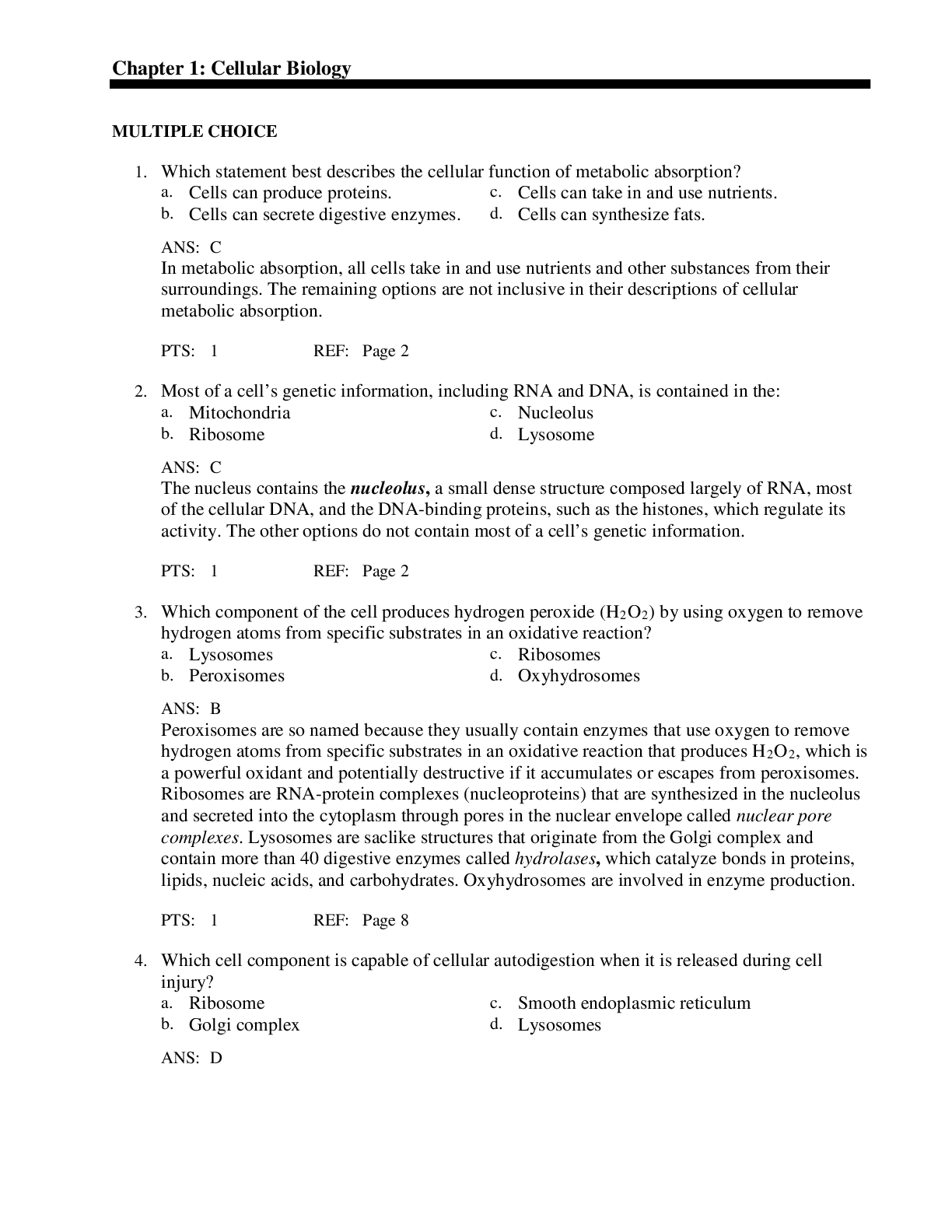

.png)
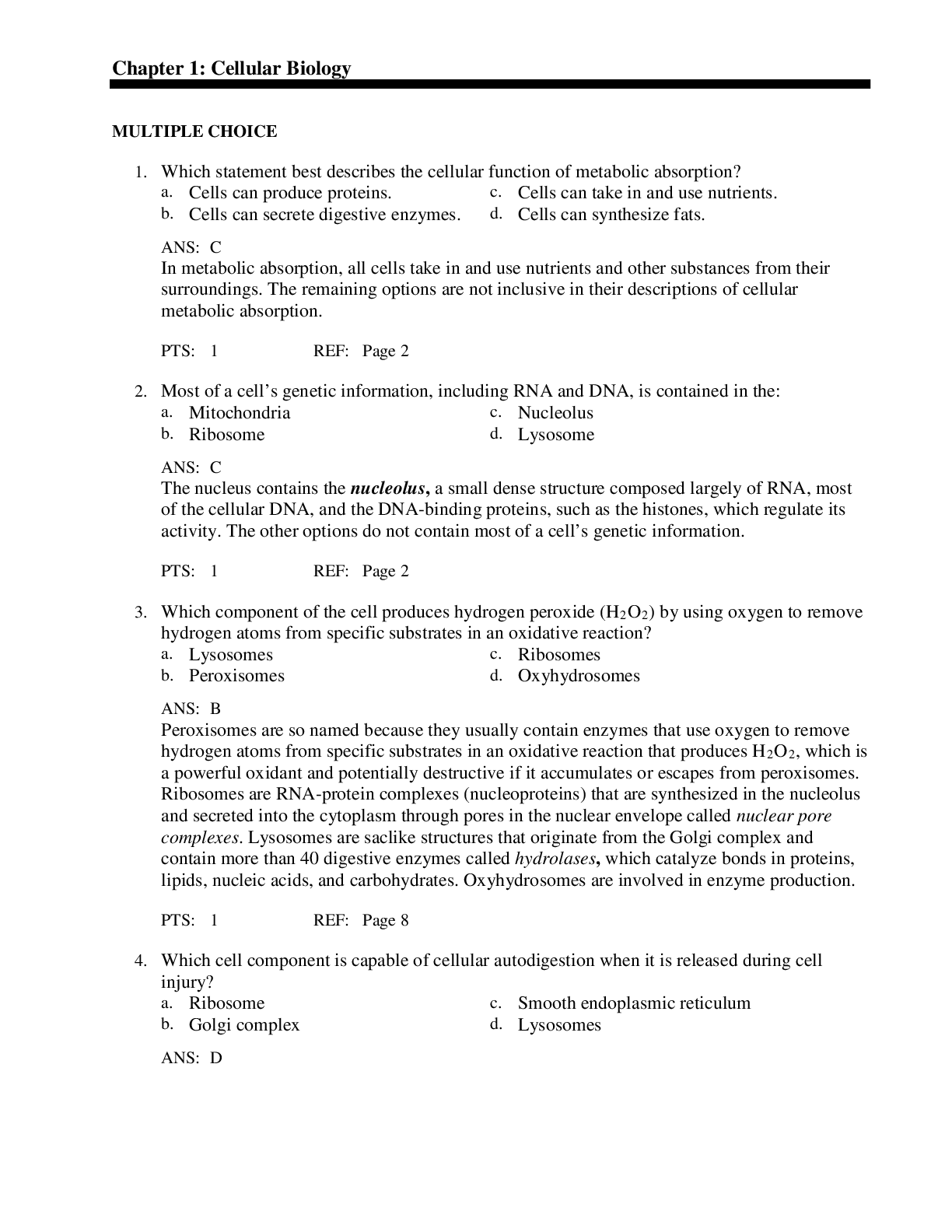
.png)



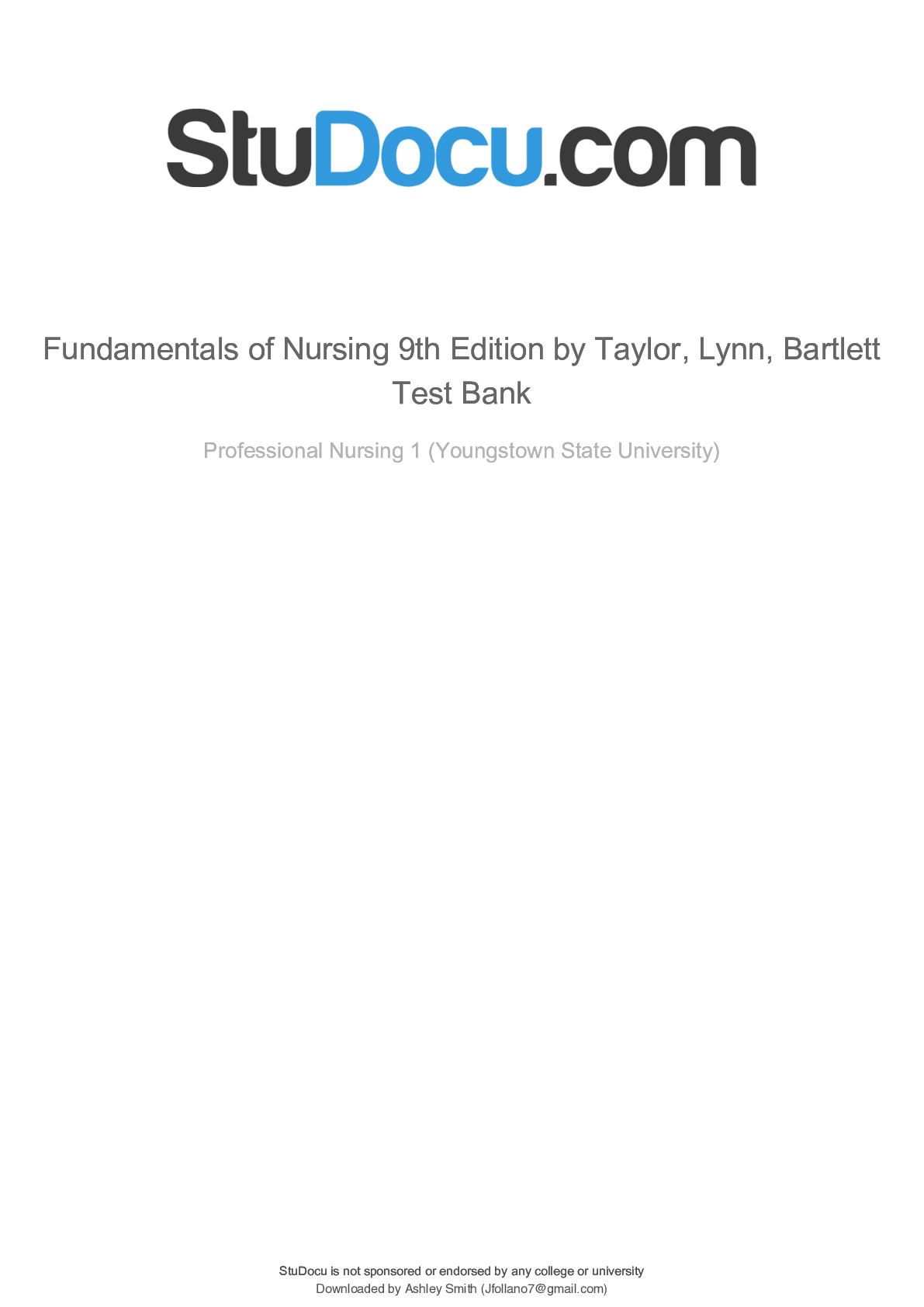
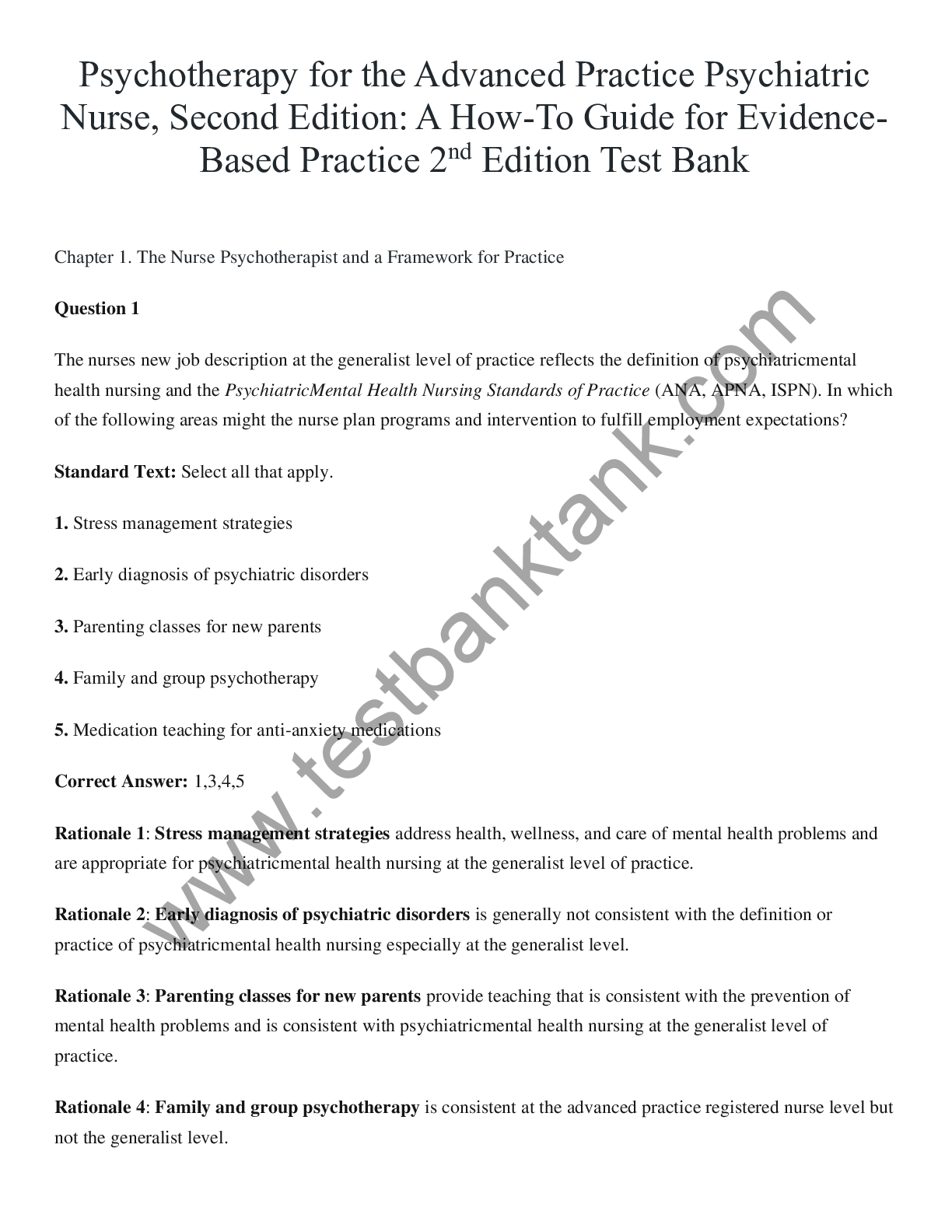
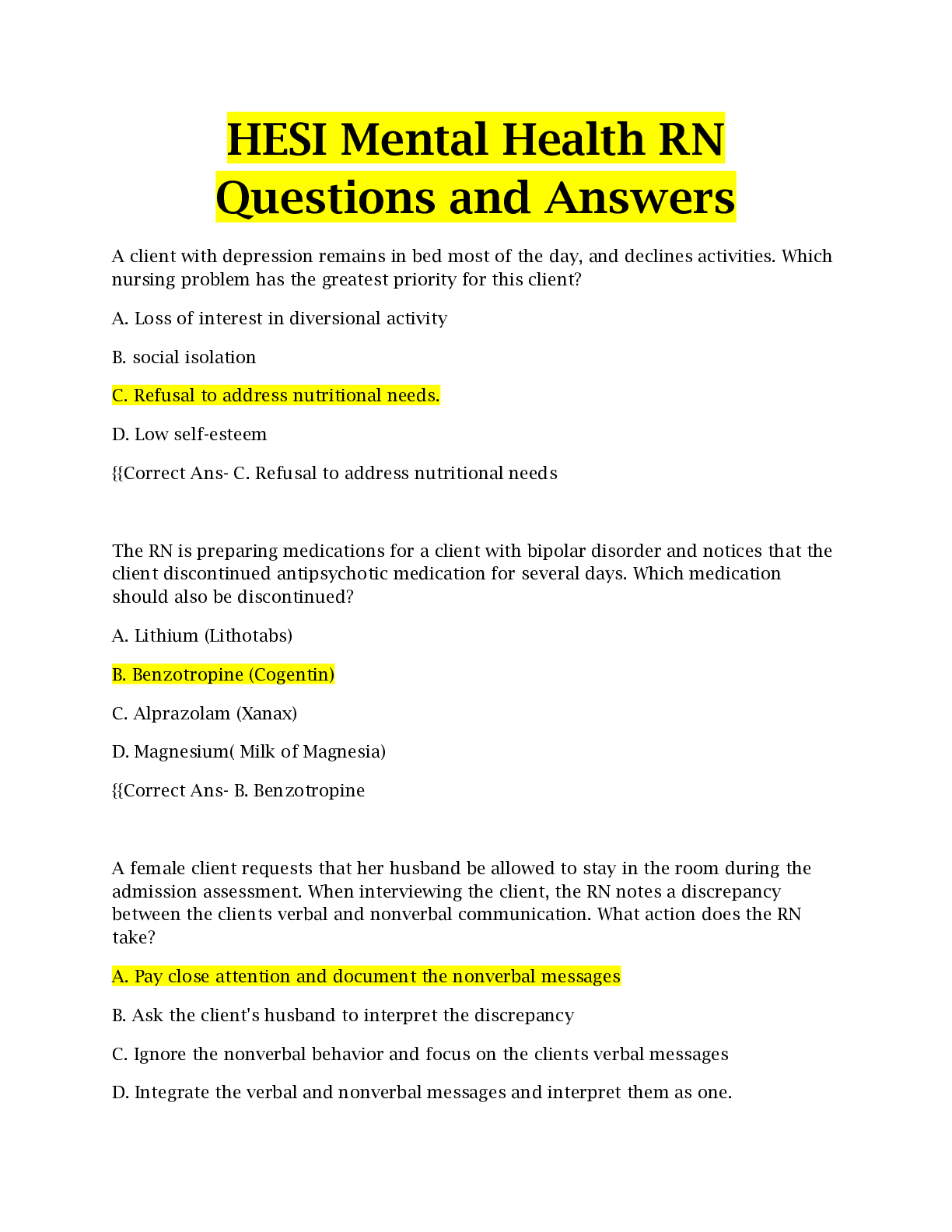
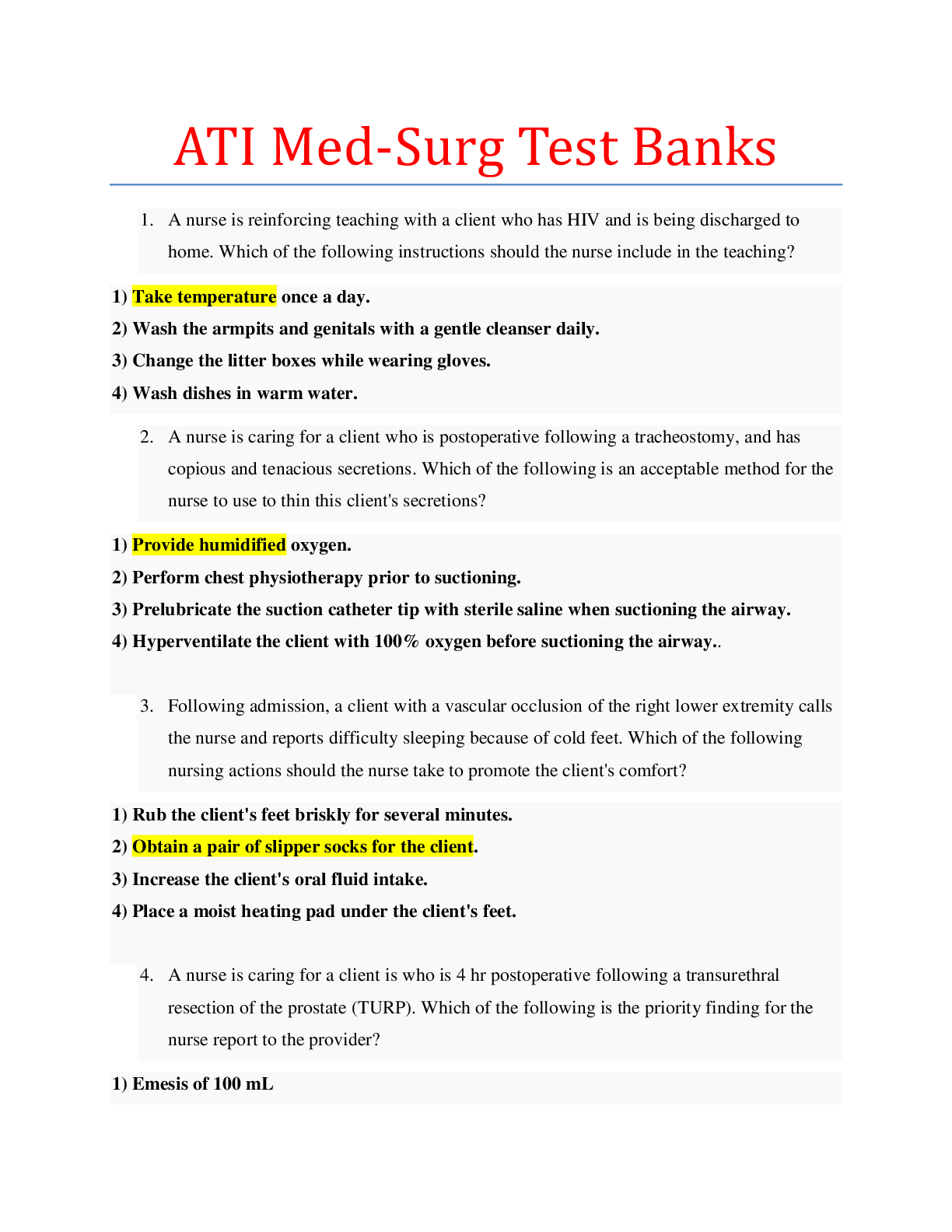

.png)
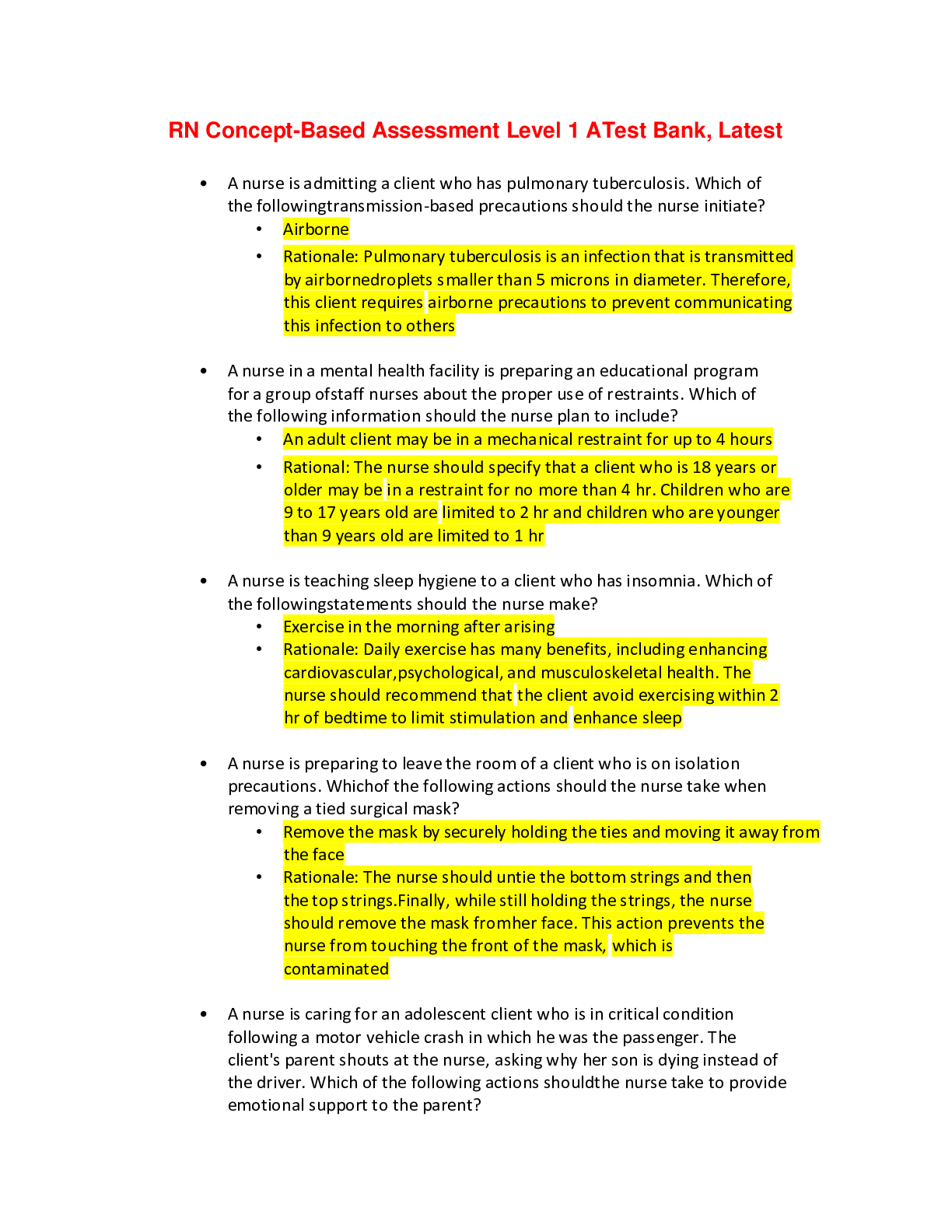
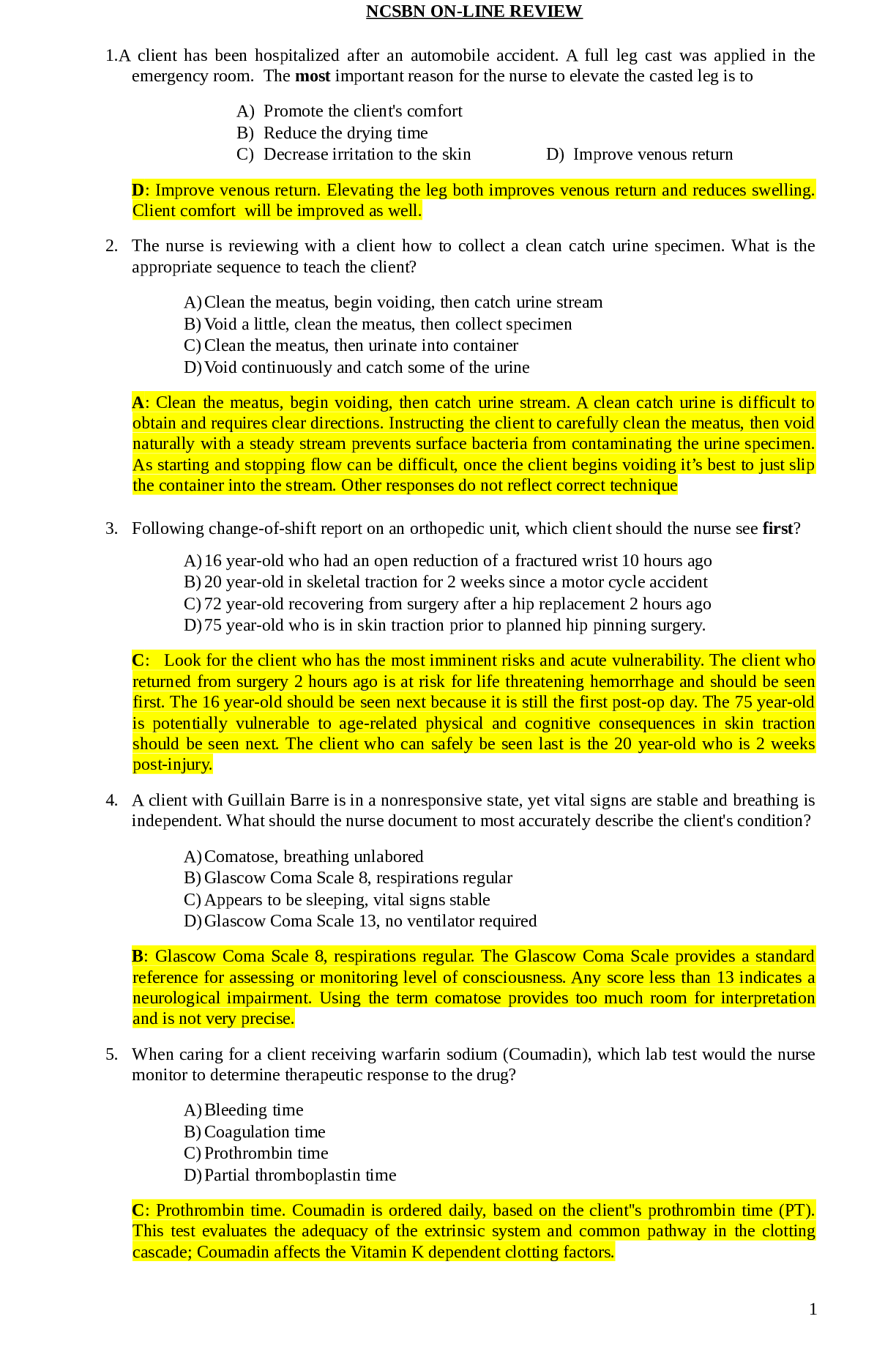

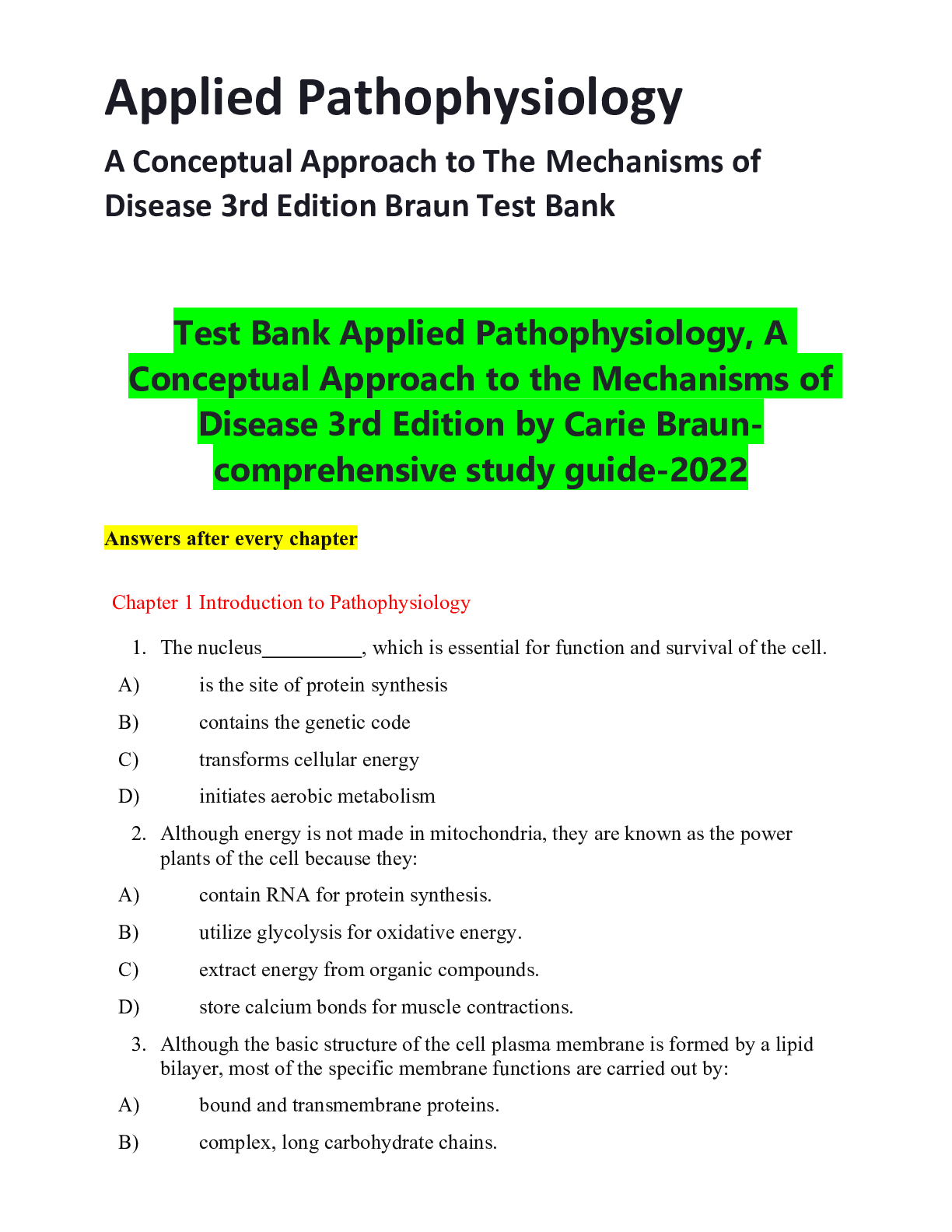

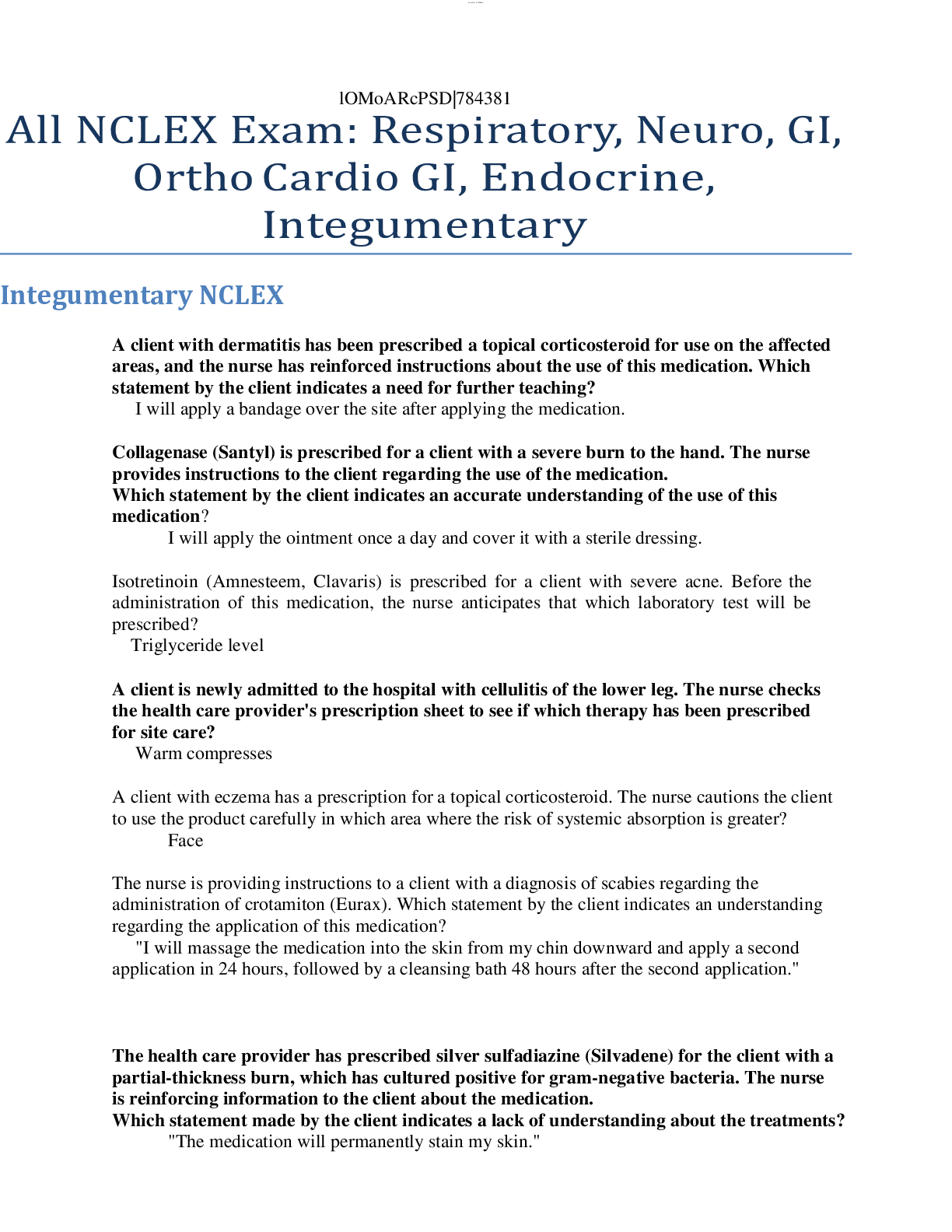
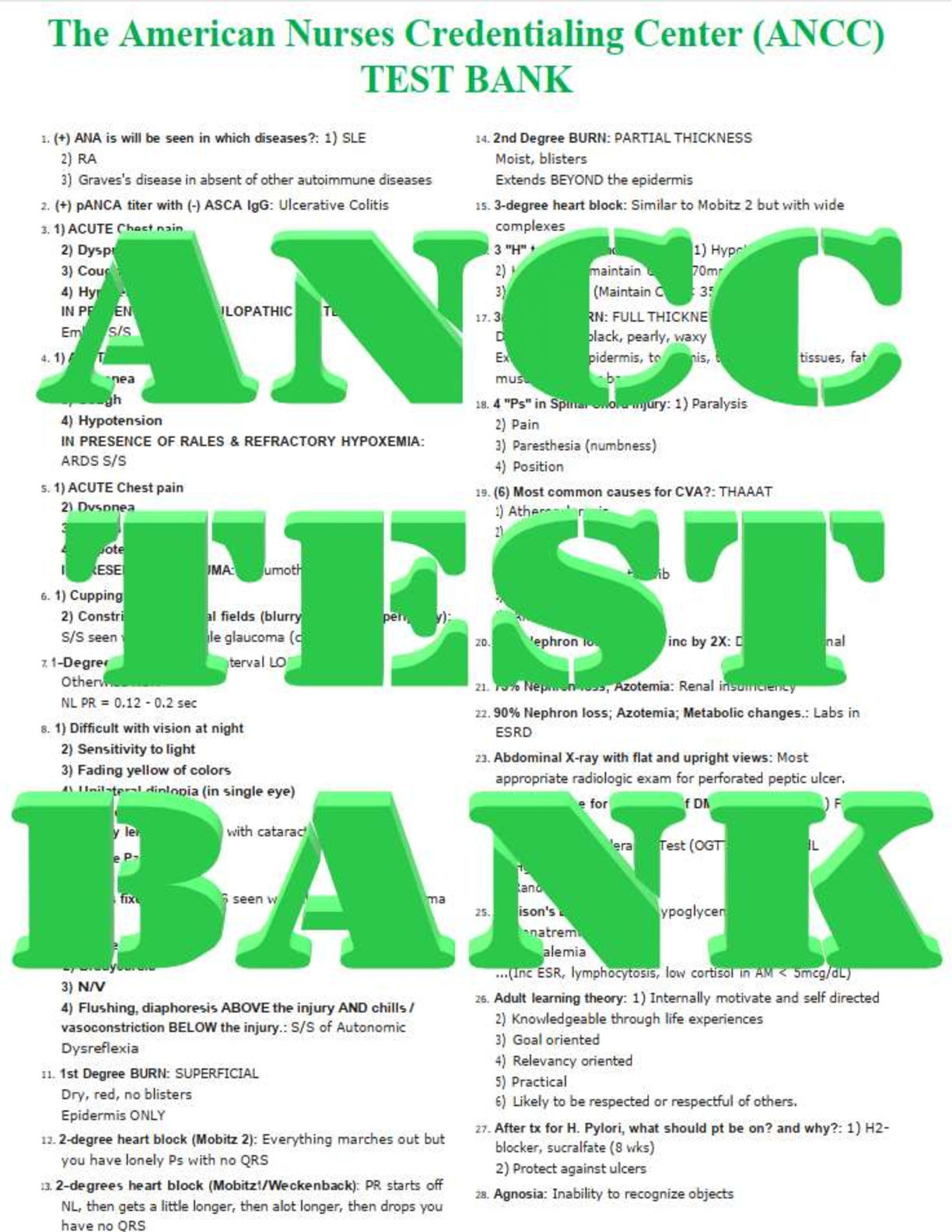
.png)
.png)
